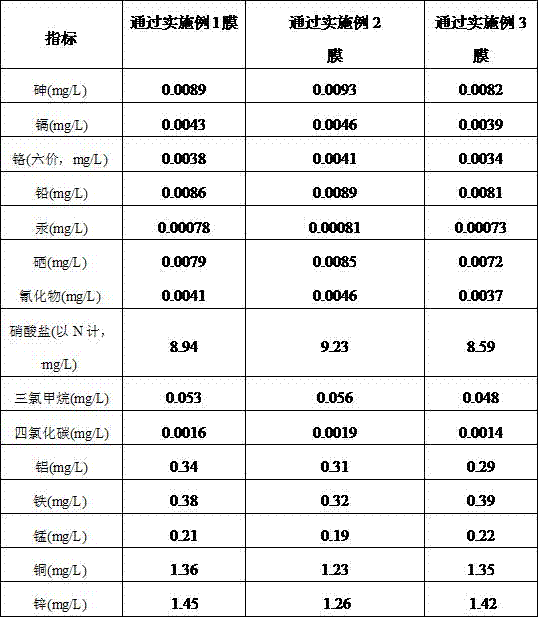Sewage treatmentceramic membrane prepared with 3D printing technology and preparation method of sewage treatmentceramic membrane
A sewage treatment and 3D printing technology, applied in water/sewage treatment, adsorbed water/sewage treatment, water/sludge/sewage treatment, etc., can solve problems such as water shortage, achieve low cost, simple preparation process, shock resistance good performance
- Summary
- Abstract
- Description
- Claims
- Application Information
AI Technical Summary
Problems solved by technology
Method used
Image
Examples
preparation example Construction
[0031] The preparation method of the sewage treatment ceramic membrane prepared by using 3D printing technology comprises the following steps:
[0032] S1: Soak diatomite, montmorillonite, calcium silicate, activated carbon, zeolite, and attapulgite in deionized water to wash off the attached pollutants, then dry them until the water content is ≤2%, and then dry them The diatomite, montmorillonite, calcium silicate, activated carbon, zeolite, attapulgite, and carbon fiber, titanium dioxide particles, alumina powder, magnesium oxide powder, and glass fiber are put into the nano pulverizer at a speed of 1000-1200r After pulverizing for 1-1.5h at / min, pass through a sieve to obtain mixture A;
[0033] S2: Put the mixture A, polyhydroxyvalerate, polybutylene succinate, initiator, catalyst and toughening agent prepared in step S1 at a temperature of 220-260°C and a speed of 400-600r / min After stirring for 2-3 hours, put it into a nano pulverizer to pulverize to obtain the mixture...
Embodiment 1
[0038] A ceramic membrane for sewage treatment prepared by 3D printing technology, including the following raw materials in parts by weight: 70 parts of diatomite, 60 parts of montmorillonite, 25 parts of calcium silicate, 25 parts of activated carbon, 18 parts of zeolite, concave-convex 20 parts of stick clay, 20 parts of carbon fiber, 6 parts of polyhydroxyvalerate, 7 parts of polybutylene succinate, 15 parts of titanium dioxide particles, 10 parts of alumina powder, 13 parts of magnesium oxide powder, 5 parts of glass fiber, 0.6 parts of initiator, 0.8 parts of catalyst, 0.5 parts of tackifier, 1.5 parts of toughening agent, 1.2 parts of coagulant, and 0.8 parts of stabilizer.
[0039] The initiator is tert-butyl peroxy tert-valerate.
[0040] The catalyst is a platinum catalyst.
[0041] The tackifier is propyltrimethoxysilane.
[0042] The toughening agent is polybutadiene rubber.
[0043] The coagulant is polyaluminum chloride.
[0044] The stabilizer is an organotin...
Embodiment 2
[0051] A ceramic membrane for sewage treatment prepared by 3D printing technology, including the following raw materials in parts by weight: 64 parts of diatomite, 50 parts of montmorillonite, 20 parts of calcium silicate, 22 parts of activated carbon, 16 parts of zeolite, concave-convex 16-24 parts of stick clay, 18-22 parts of carbon fiber, 4-7 parts of polyhydroxyvalerate, 5 parts of polybutylene succinate, 13 parts of titanium dioxide particles, 8 parts of alumina powder, 10 parts of magnesium oxide powder , 4 parts of glass fiber, 0.4 part of initiator, 0.4 part of catalyst, 0.3 part of tackifier, 1.2 part of toughening agent, 1 part of coagulant, and 0.6 part of stabilizer.
[0052] The initiator is tert-butyl peroxy tert-valerate.
[0053] The catalyst is a platinum catalyst.
[0054] The tackifier is propyltrimethoxysilane.
[0055] The toughening agent is polybutadiene rubber.
[0056] The coagulant is polyaluminum chloride.
[0057] The stabilizer is an organotin...
PUM
 Login to View More
Login to View More Abstract
Description
Claims
Application Information
 Login to View More
Login to View More - R&D
- Intellectual Property
- Life Sciences
- Materials
- Tech Scout
- Unparalleled Data Quality
- Higher Quality Content
- 60% Fewer Hallucinations
Browse by: Latest US Patents, China's latest patents, Technical Efficacy Thesaurus, Application Domain, Technology Topic, Popular Technical Reports.
© 2025 PatSnap. All rights reserved.Legal|Privacy policy|Modern Slavery Act Transparency Statement|Sitemap|About US| Contact US: help@patsnap.com


